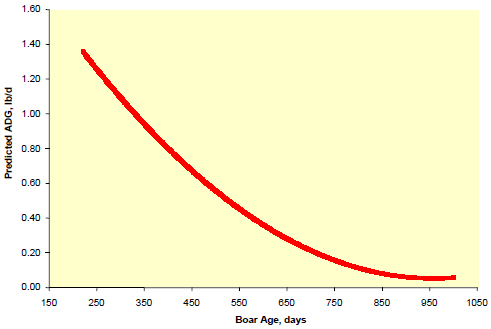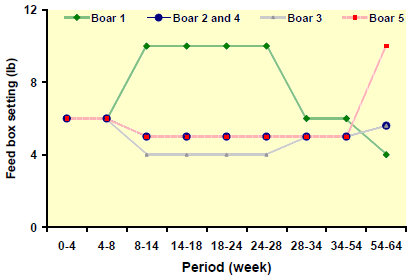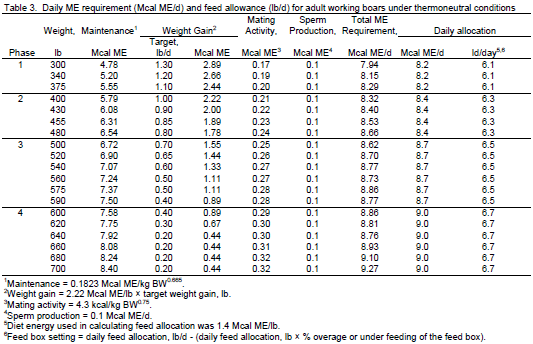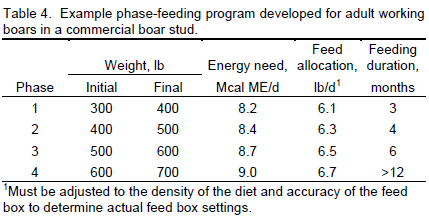



Boar Nutrition
Mike Tokach and his colleagues at Kansas State University's Applied Swine Nutrition Team offered practical tips on feeding boars at the Swine Profitability Conference 2009.Introduction
During a pre-conference session at the 2007 AASV National meeting, Dr Tokach said he addressed the topic of feeding boars for optimum sperm production and discussed each nutrient area in depth1. In reality, most boar nutrition papers repeat the same information because little new research has been conducted in recent years. Instead of repeating that information in this paper, Dr Tokach addressed the more practical aspects facing people in the boar stud.
Most boar stud diets are adequate or in excess for amino acids, vitamins and minerals. The main question for boar stud managers is the level of energy that should be provided to the boars on a daily basis, i.e. how much feed should each boar receive? The author has conducted a couple of interesting experiments to determine how boars were being fed in one of our larger boar studs serving Kansas producers and to help them determine if there was a better way for them to set feeding levels. In this paper, we will relate some of the things that we have learned from this experience and propose a simple method to set feeding levels for boars in studs.
Feed Requirements of Boars
Four main variables influence the amount of feed that boars should receive on a daily basis: 1) weight of the boar determines the maintenance energy requirement; 2) desired growth rate; 3) energy level of the diet; and 4) accuracy of the feed delivery system (automatic feed line with gestation feed drop in most studs).
How Much do Boars Weigh?
Weight of boars in the stud can be determined by physically weighing the boar with a scale or by using a flank tape, as used with gestating sows. The estimated weight of the boars can be determined using the equation or data presented in Table 1. After weighing boars in studs, it was found that the same flank-to-flank equation used with sows can be used to estimate weights of boars in a stud2. As will be discussed below, the most important time to know the weight of the boar to set the feeding programme is at entry into the stud to determine the amount of time to leave them on the first feeding level.

How Fast do Boars Grow in the Stud?
In previous studies, slow-growing boars fed at maintenance have shown significantly decreased libido, semen volume and sperm output. On the other hand, fast-growing boars fed at high rates are thought to have increased leg and libido problems. Rate of weight gain may also have an impact on longevity, and thus affect lifetime semen production.
Even though growth rate is important, boars do not have a target growth rate in most studs. Establishing a target growth rate is quite beneficial in setting feeding levels because the desired growth rate determines the greatest portion of the boars feed needs other than their maintenance requirement. Instead of having a target growth rate, feed is provided to the boar and after their requirements for maintenance, semen production and activity is met, the feed left over determines the growth rate. Thus, growth rate is the consequence of the feeding level rather than being used to determine the feeding level.
Instead of weighing boars over time to establish growth curve, the author has used a procedure developed in finishing pigs where all of the boars in the stud are weighed over a relatively short period of time. By plotting the age of the boar against the weight (Figure 1), a weight per day of age growth curve can be determined3. The weight per day of age curve can be used to estimate the average daily gain (ADG) at any body weight to develop an ADG curve (Figure 2). The growth rates existing in the stud can be compared to suggested growth curves (Table 2). As shown in the example in Table 2, boars in many studs have faster ADG at lower weights than the suggested targets, which indicates they are probably being fed more than the optimum feeding level.



How Much Does Feed Intake Vary over a Boar’s Life in the Stud?
In a recent trial, the author recorded feed box settings for boars in a stud as part of a research project4. When the crew in the stud set the feed boxes based on their monitoring of body condition of the boars, there were big changes in growth rates over the course of the trial caused by a cyclic pattern of increasing and decreasing feed allocation of individual boars to either reduce or compensate body condition (Figure 3). Boars were fed as much as 11.2 lb/day when they were below the stud’s acceptable body condition and as little as 4.5 lb/day when individual boars were believed to need to lose condition. At this low level of feeding, boars were being fed close to or below their maintenance requirements because the feed boxes were actually dropping less feed than indicated by the volume measurement on the box.

Much like the data found with gestating sows, allowing feed levels to be set based on body condition can result in rapid changes in feed box settings that alter growth rate of the boars substantially.
How Much Feed are Boxes Actually Dropping?
Feed boxes used in gestation barns and most boar studs are set on a volumetric basis instead of weight. Thus, the box drops a set volume of feed. The volume measurement is impacted by the bulk density of the diet and whether the drop is mounted perpendicular to the feed line5. As the bulk density of the diet decreases, volume must be increased to attain the same pounds of intake. Although this seems like a simple concept, most people that adjust the boxes give little thought to the bulk density of the diet. Most diets fed in boar studs include some lower energy ingredient to lower the bulk density and increase the fibre level. If this is not considered in setting feed boxes, boars may be fed considerably less energy and other nutrients than desired. Conversely, some boxes may drop more feed than indicated on the volumetric measure on the feed box. In a recent trial, it was found that boxes in one stud dropped approximately 12 per cent more feed than indicated by the settings on the feed box.
Fortunately, when comparing desired feeding levels to actual amounts dropped by various feed drops, inaccuracies are linearly related to the setting on the box5. Thus, if you determine that boxes in a stud drop 12 per cent more or less of a particular diet than the setting on the box indicates, you can adjust all feeding levels in a feeding chart by 12 per cent to account for the difference.
Is There an Easier Way to Set Feeding Levels?
For boars housed in their thermoneutral zone, energy requirements are determined by the energy need for maintenance, growth rate, semen production and mating activity (Table 3). The requirements for mating activity and semen production are relatively low with the majority of the energy requirement driven by the weight of the boar and desired growth rate. The total energy requirement of the boar increases from 7.9 to 9.3 Mcal/day as it grows from 300 to 700 lb. By dividing this weight range into 100-lb increments, boars can be phase fed based on time to closely meet their energy requirements.
In this example, once the boars reach 300 lb, they would be fed 6.1, 6.3, 6.5 and 6.7 lb/day for 3, 4, 6 and 12 months, respectively (Table 4). Weighing the boars or taping them with a weight tape will determine whether the feeding duration should be reduced for the first feeding level. For example, if a group of boars average 350 lb when they enter the stud, the feeding length of the first feeding level should be reduced from three months to approximately six weeks.
Steps to Implement the Feeding Programme
The steps to implementing this feeding programme would be to:
- Determine energy density of the diet (ME/lb) and adjust feed levels in Table 4 to the energy density of the diet.
- Determine accuracy of the feed drops to determine whether feed levels in Table 4 need to be increased or decreased by a certain percentage.
- Determine the weight of boars as they enter the stud to determine the length of time to feed the first feeding level, and
- Set the boxes and monitor individual boars.
Does this Feeding Programme Work?
The author recently completed a test with one stud where this feeding strategy had been implemented, and compared it to their previous programme of feeding boars based on body condition.4
Boars that were fed according to the planned feeding strategy followed the desired growth curve (Figure 4) while boars being fed based on body condition were more erratic in growth rate due to fluctuations in feeding levels over the course of the study (Figure 3). Although the number of boars on the study was not great enough to test the impact of the feeding programme fully on boar longevity, a higher proportion of active boars (73 vs. 42 per cent) were maintained at the end of the 16-month study in boars fed the planned feeding programme than those fed based on body condition. Boars fed based on body condition tended to be overfed when initially placed in the stud and underfed during later periods.
The results of this trial indicated that AI boars can be fed to a set feeding level to achieve targeted weight gains to influence longevity without affecting semen production and quality. More research is required to validate that the planned feeding regimen influences longevity of boars in the stud.
References
- Tokach, M.D. and R.D. Goodband. 2007. Feeding Boars for Optimum Sperm Production. Proceedings of Swine Reproduction Preconference Symposium at 2007 AASV Annual Meeting.
- Sulabo, R.C., J. Quackenbush, R.D. Goodband, M.D. Tokach, S.S. Dritz, J.M. DeRouchey and J.L. Nelssen. 2006a. Validation of flank-to-flank measurements for predicting boar weight. KSU Swine Day Publication 19-23. http://www.KSUswine.org. Accessed 7 November 2008.
- Sulabo, R.C., J. Quackenbush, R.D. Goodband, M.D. Tokach, S.S. Dritz, J.M. DeRouchey and J.L. Nelssen. 2006b. Predicting growth rates of adult working boars in a commercial boar stud. KSU Swine Day Publication, 13-18. http://www.KSUswine.org. Accessed 7 November 2008.
- Sulabo, R.C., J. Quackenbush, R.D. Goodband, M.D. Tokach, S.S. Dritz, J.M. DeRouchey and J. L. Nelssen. 2008. Effects of different feeding regimens on growth, longevity, and semen characteristics of working boars in a commercial AI stud. KSU Swine Day Publication, 22-30. http://www.KSUswine.org. Accessed 7 November 2008.
- Schneider, J.D., M.D. Tokach, S.S. Dritz, J.L. Nelssen, J.M. DeRouchey and R.D. Goodband. 2008. Determining the accuracy of gestation feed drops. Swine Health and Production 16:298-303.
Further Reading
| - | You can view other papers presented at Swine Profitability Conference 2009 by clicking here. |
June 2009










